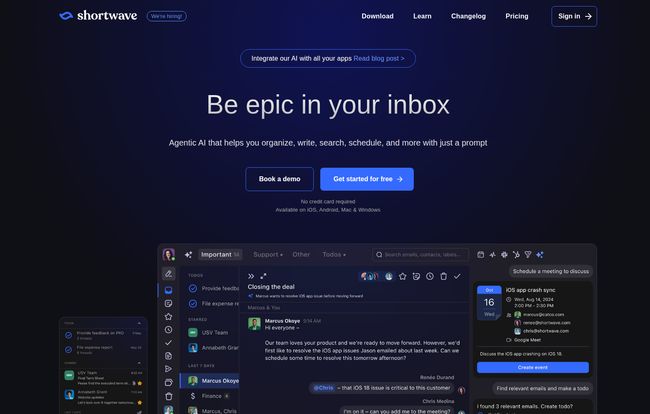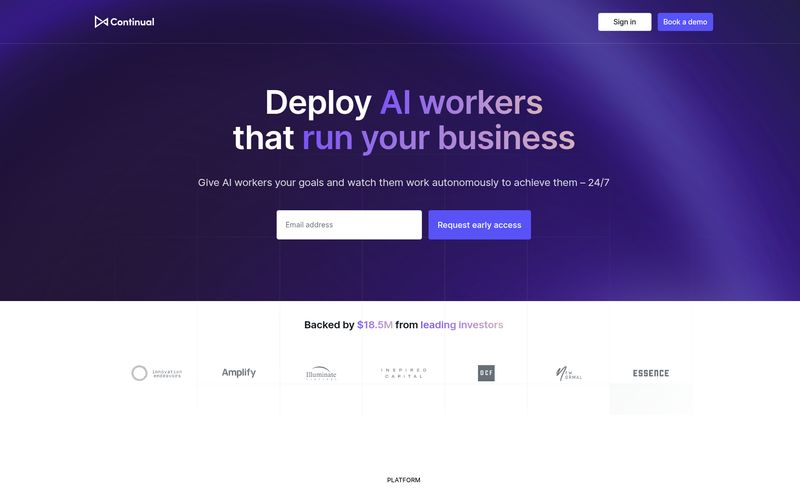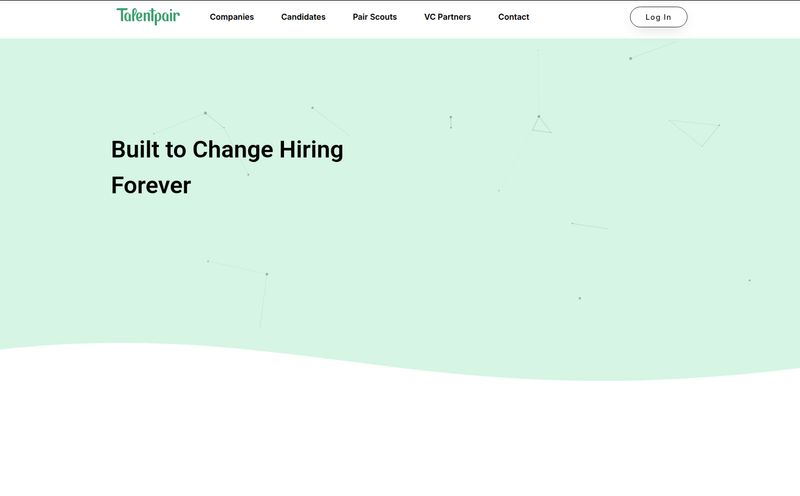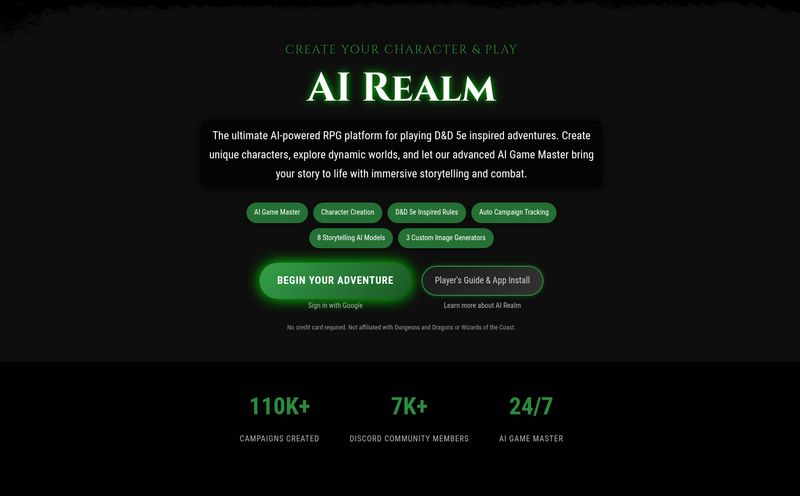For most of us in the digital trenches—SEOs, marketers, founders, you name it—our inbox is less of a communication tool and more of a high-stress, never-ending to-do list dictated by other people. We've all tried the filters, the labels, the 'Inbox Zero' methodologies that last about a week. It’s a constant battle. And most of the time, the inbox wins.
So when another tool comes along promising to “Be zen-like in your inbox,” my professional-grade skepticism kicks in. I've seen it all. But Shortwave… Shortwave feels different. It’s not just another skin for Gmail; it’s an AI-powered copilot designed to fundamentally change how you interact with email. And after spending some serious time with it, I'm starting to think they might actually be onto something.
So, What Exactly is Shortwave?
Think of Shortwave as a smart layer that sits on top of your existing Gmail account. It doesn't replace it, it enhances it. At its heart, it’s an AI email assistant that helps you organize, search, write, and even schedule things without ever leaving your inbox. The big deal here is the 'agentic AI'. That's just a fancy way of saying the AI is proactive and can take actions for you. No more awkwardly copying an email thread and pasting it into ChatGPT with the prompt, “Summarize this nightmare chain.”
Instead, Shortwave is like having a tiny, hyper-efficient intern living in your browser. An intern that already knows your contacts, understands your project context, and, most impressively, learns to write like you.

Visit Shortwave
The AI Features That Actually Change the Game
Okay, “AI-powered” is the marketing buzzword of the decade. But what does it actually do? I'm glad you asked. Some of this stuff is genuinely cool.
Your Personal Ghostwriter Who Sounds Like You
This is the showstopper for me. Shortwave’s AI writing assistant learns your personal style from your sent emails. The more you use it, the better it gets. You can give it simple prompts like, “Politely decline this meeting” or “Draft a follow-up asking for the Q3 report,” and it generates a draft in your voice. It’s not the generic, overly formal tone we've come to expect from AI. It's uncanny. It even picks up on my habit of using em-dashes. This alone has saved me hours of agonizing over simple replies.
Inbox Zero Isn't a Myth Anymore
Shortwave’s approach to inbox organization is brilliant. It automatically bundles similar emails—like newsletters, notifications from tools like Asana or Google Docs, and calendar invites—into neat little piles. Instead of 50 individual notifications, you get one bundle you can scan and archive in a single click. It's like having a digital mailroom clerk sorting everything before it even hits your desk.
Then there's the Triage system. You can quickly pin important threads, snooze emails for later (a classic, but executed perfectly here), or mark them as Done. Your inbox becomes less of a chaotic marketplace and more of a prioritized work queue. It’s a subtle shift, but it has a massive impact on my daily anxiety levels.
A Search Bar That Actually Reads Your Mind
Ever tried to find a specific attachment or piece of information in Gmail's native search? It can be a nightmare. "Was it in a thread with Dave or David? What was the subject line again?" Shortwave's AI-powered search is on another level. You can use natural language, like “that contract Bob sent me last quarter” or “the flight confirmation for my trip to Austin.” Because it has the context of your entire email history (depending on your plan), it finds things with spooky accuracy. It's a lifesaver for anyone who deals with a high volume of client communication or project files.
Playing Nicely With The Team
This is where Shortwave moves from a personal productivity tool to a proper business solution. For teams, you can collaborate right inside the inbox. You can assign an email to a teammate like a task, have a side conversation in the comments (no more messy FWD: FWD: chains!), and create shared templates for common responses. It turns the traditionally siloed inbox into a collaborative workspace, which is a massive plus for support, sales, and operations teams.
Let's Talk Money: A Look at Shortwave Pricing
Alright, this kind of power isn't entirely free. Shortwave operates on a subscription model, and honestly, for the right user, it's worth every penny. Here’s a quick breakdown of their main plans, billed annually:
- Pro Plan: At $14 per seat/month, this is the entry point for small teams and power users. You get most of the core features, AI assistance, and a 2-year search history. A great starting point.
- Business Plan: For $24 per seat/month, this is the sweet spot in my opinion. It gives you unlimited AI usage, a 5-year search history, and more advanced team features. If your business runs on email, this is likely the one.
- Premier Plan: At $36 per seat/month, this is for the serious players. You get unlimited email history search (a huge deal), priority support, and all the most powerful AI and sales features.
They do offer a 14-day free trial, which is more than enough time to see if it'll click for you. I'd recomend starting there and seeing just how much cleaner your inbox feels after a few days.
The Good, The Bad, and The Gmail-y
No tool is perfect, right? Here’s my honest take. The biggest pro is the agentic AI that genuinely saves time. The personalized writing and smart summaries are fantastic. The team collaboration features are also a huge win over a standard Gmail setup.
On the flip side, the biggest limitation is that it’s primarily focused on Gmail accounts. If your company is on Microsoft 365, you're out of luck for now. Also, the AI's effectiveness is directly tied to your email history. If you're starting with a brand-new account, it'll take a while for it to learn your style. It's not an instant magic wand, it's a tool that grows with you.
So, Is Shortwave Worth the Hype?
For me, the answer is a resounding yes. If you're a professional who feels like you're constantly fighting a losing battle with your inbox, Shortwave could be the reinforcements you've been waiting for. It's not just about getting to 'inbox zero'; it's about reducing the cognitive load that email puts on us every single day.
If you're a casual email user, it's probably overkill. But for business owners, team leads, sales professionals, and freelancers whose livelihood depends on timely and effective communication, Shortwave isn't just a nice-to-have. It’s a competitive advantage.
Frequently Asked Questions about Shortwave
- How does Shortwave keep my email data secure?
- Shortwave uses Google's own secure APIs to access your email. It's built with privacy and security in mind, leveraging Google's infrastructure. They have a detailed privacy policy on their site that's worth a read if you have specific concerns.
- Can I use Shortwave with my Outlook or non-Gmail account?
- Unfortunately, no. As of now, Shortwave is designed exclusively for Google and Gmail accounts. They've focused on creating a deep, seamless integration with one platform rather than a shallow one across many.
- What happens if I cancel my Shortwave subscription?
- Since Shortwave works on top of your Gmail, all your emails are still safe and sound in your Google account. You'll lose the Shortwave interface and its AI features, but your data remains yours, accessible through the standard Gmail app.
- Is the AI writing really that good?
- I was skeptical too, but yes, it's impressive. The key is that it learns from your actual writing. It's not just a generic text generator. Give it a week of steady use during the free trial, and you'll see a noticeable improvement in how well it captures your voice.
- Can I try it before I buy it?
- Absolutely. Shortwave offers a 14-day free trial with no credit card required upfront. This gives you plenty of time to explore all the features and decide if it's the right fit for your workflow.
Final Thoughts
Look, I'm a professional cynic when it comes to productivity apps. Most of them promise a revolution and deliver a slightly better-looking checklist. Shortwave is different. It’s a thoughtfully designed, powerful tool that addresses the core problems of modern email overload. It gave me back time and, more importantly, mental energy. And in this economy, you can't really put a price on that.



